
If you are looking to take a day trip from Fukuoka, look no further than Dazaifu, a city located less than an hour away from Fukuoka City by train or bus. The city offers visitors temples, shrines, museums, shopping streets, historical sights, and more.
Although Dazaifu wasn’t officially founded as a city until 1982, its history goes back over a thousand years. During the Nara and Heian periods (710-1185), Dazaifu played an important role as the political center of the island of Kyushu, Japan.
Here is what to do with one day in Dazaifu.
If you are looking for more information about Japan, I highly recommend you pick up a guidebook such as Lonely Planet Japan.Table of Contents
Why visit Dazaifu?
The main reason for visiting Dazaifu is to visit Dazaifu Tenmangu Shrine, a shrine with hundreds of plum trees. But there is more to this city, including Zen rock gardens at Komyozenji Temple, the newly opened Kyushu National Museum, and the ruins of the government office that stood for a thousand years.
Whether you have one hour or a full day, a day trip to Dazaifu is worth the effort. Being only 15 kilometers (9 miles) away from Fukuoka makes Dazaifu a convenient location for a day trip.
How to get to Dazaifu from Fukuoka (Hakata)
There are a few ways to reach Dazaifu from Fukuoka City. They include the Nishitetsu Railway, a direct bus, and Japan Rail combined with Nishitetsu Railway.
Just a reminder. The main station in Fukuoka is known as Hakata Station. It is here where Kyushu Shinkansen and San’yō Shinkansen trains arrive and depart. For train schedules and maps, you will need to search Hakata, not Fukuoka.
By Nishitetsu Railway
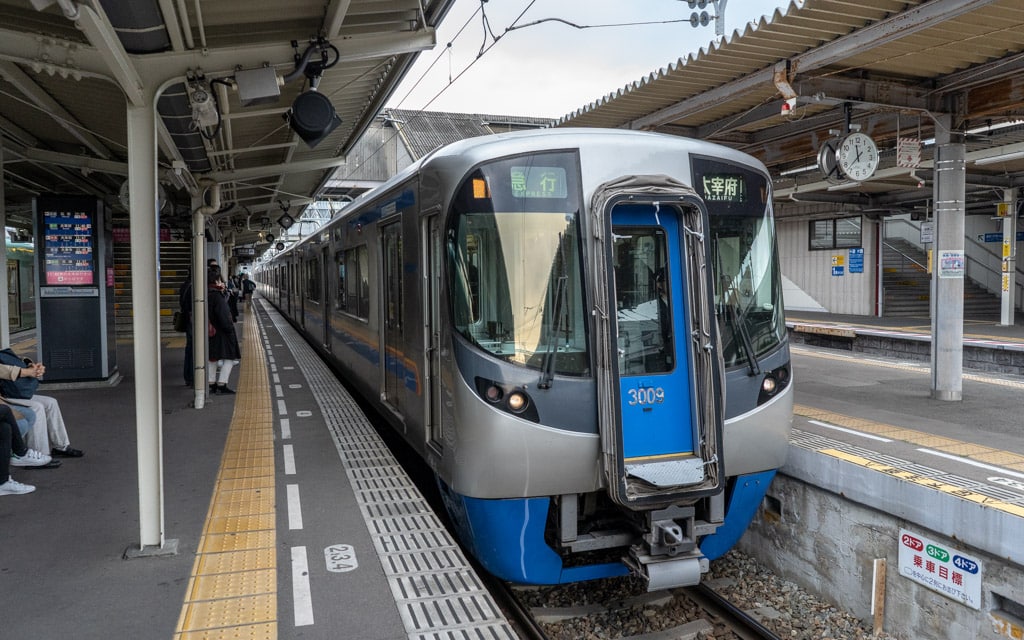
The easiest way to reach Dazaifu from Fukuoka is by Nishitetsu Railway.
Trains departing towards Dazaifu do not leave from Hakata Station, where JR shinkansen trains arrive and depart, but from Nishitetsu Fukuoka (Tenjin) Station (Hyperdia: Nishitetsufukuoka(Tenjin)). This station is located west of Hakata Station.
Local, Limited Express, and Express trains depart from Nishitetsu Fukuoka (Tenjin) Station towards Dazaifu, but only certain trains do not require a transfer. Unless you need to stop at all stations, do not take a local train. What you want to take is a Limited Express or Express train. No matter which train you take, the fare will be 400 yen.

If you take a Limited Express train, you will need to transfer at Nishitetsu Futsukaichi Station (Hyperdia: Nishitetsufutsukaichi). This part of the journey takes 16 minutes. From Nishitetsu Futsukaichi Station, board a Dazaifu Line train (Platform 1 or 4) with a final stop at Dazaifu Station. This part of the journey takes 4-5 minutes.
If you take an Express train, the process is almost the same as taking a Limited Express train. The only difference being that select Express trains do not require a transfer. On weekdays at 9:15AM, 9:46AM, 10:16AM, and 10:49AM and on weekends at 9:16AM, 9:47AM, 10:18AM, 10:48AM, 11:18AM, and 11:48AM, trains departing from Nishitetsu Fukuoka (Tenjin) Station travel to Dazaifu Station (via Nishitetsu Futsukaichi Station) without a transfer (27-33 minutes on weekdays and 27-31 minutes on weekends).
All other Express trains require a transfer as described above (28 minutes on weekdays and 28-32 minutes on weekends). Yes, this can be confusing so please take a look at the schedule above.
By Bus
A direct bus connects Fukuoka with Dazaifu. The bus departs from the Hakata Bus Center, just north of Hakata Station. A one-way fare is 600 yen. The journey takes about 42 minutes.
On the way, the bus makes a few stops, including at Fukuoka Airport (International Terminal). If you board from here, a one-way fare is 500 yen. The journey takes about 25 minutes from the airport to Dazaifu Station.
By JR Rail
Surprisingly, the most challenging way to reach Dazaifu Station from Fukuoka is by JR Rail.
So why is it difficult? There are no JR trains that directly connect Hakata Station with Dazaifu Station. You will first need to take a JR train, walk 10 minutes to another station, then connect to a Nishitetsu train.
Here is how to do it. First, take a train on the JR Kagoshima Line (13-30 minutes, 280 yen) or a Limited Express Midori/Yufu train (11-13 minutes, 280 yen) from Hakata Station to JR Futsukaichi Station.
You must walk about 10 minutes from here to Nishitetsu Futsukaichi Station, where you can take the Nishitetsu Dazaifu Line to Dazaifu Station (5 minutes, 150 yen).
The total journey will take about 30-60 minutes, depending on which train you take and how fast you walk. The total cost will be 430 yen or 150 yen for those holding a JR Rail Pass.
Arrival at Dazaifu Station
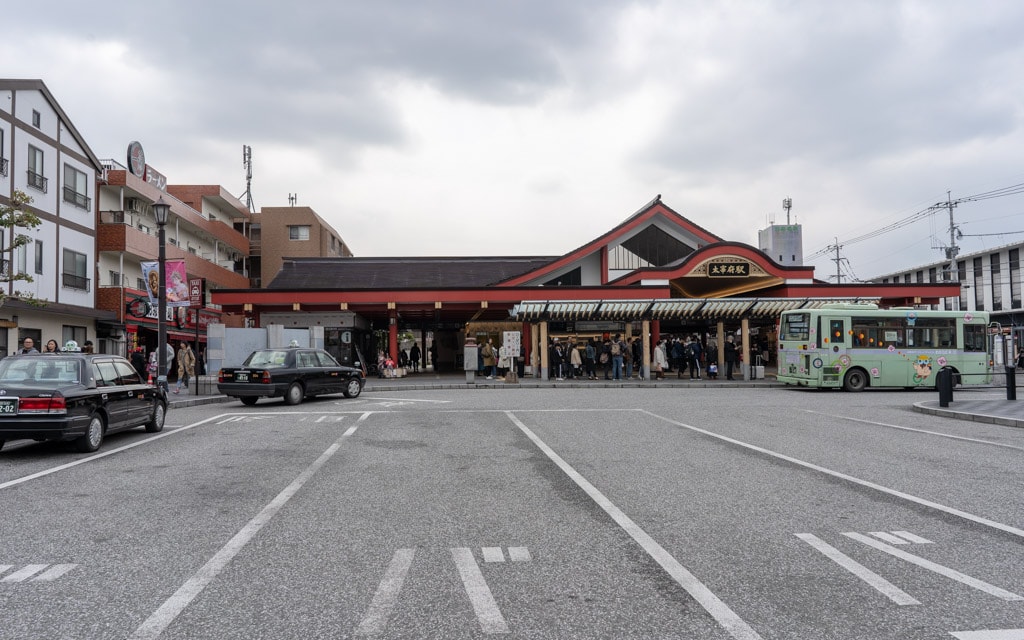
Welcome to Dazaifu Station. Although it may be small, this station has everything you need, including a tourist information office, coin lockers, buses with connections to Fukuoka and Fukuoka Airport, taxis, and bicycle rentals.
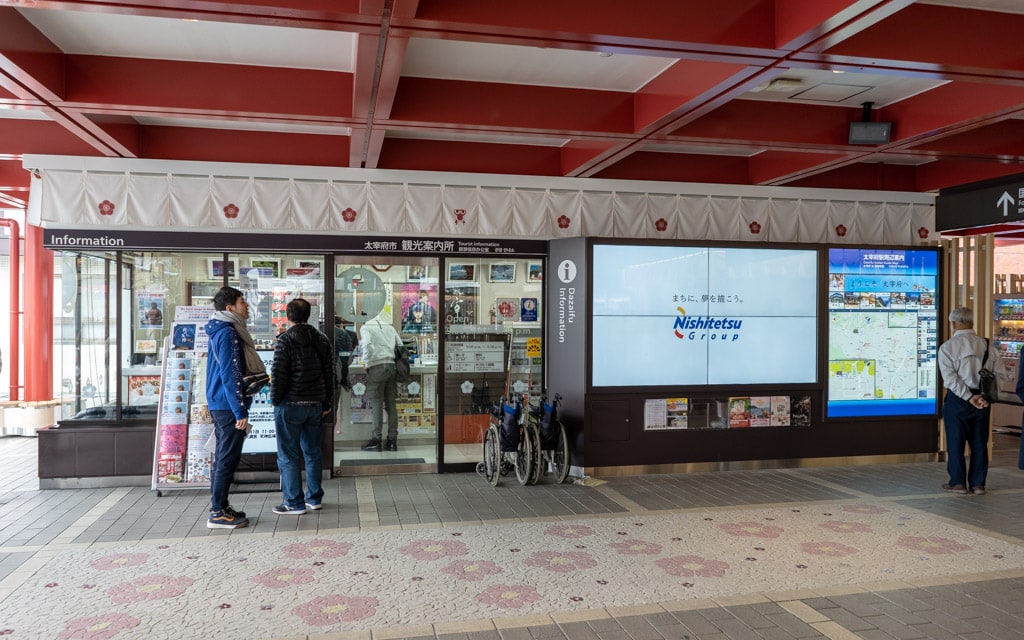
Those who need help planning their day trip to Dazaifu will find a Tourist Information Office just outside the gates of the station. The office is open daily from 9:00AM to 4:30PM.
Visitors to the office can get information about tourist sights, local buses, restaurants, and bus and train schedules. If you need a map of Dazaifu, you can find it here. They can also help answer any other questions you may have. Strollers can be rented from the office for 100 yen per hour while wheelchairs can be borrowed free of charge.
Coin Lockers

Coin lockers can be found just outside the station gates behind the Tourist Information Office for those who need to store luggage at Dazaifu Station for the day. Coin lockers start at 400 yen and go all the way up to 900 yen. Only 100 yen coins are accepted.
How to get around Dazaifu
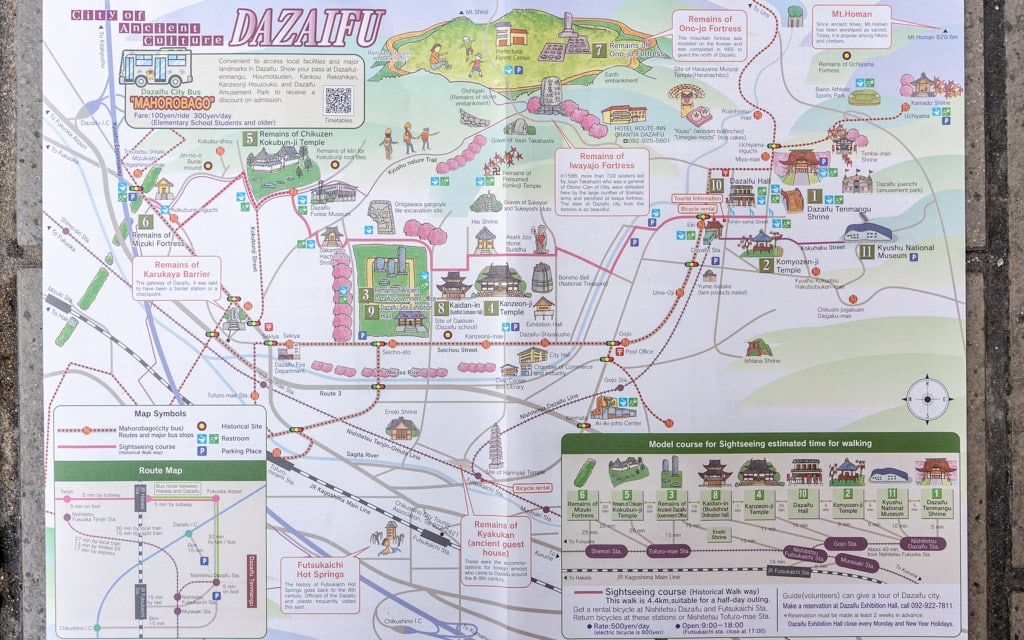
Dazaifu is a compact city, perfect for exploring on foot. Almost all sights of importance can be found within a 30 minute walk of Dazaifu Station.

A network of local buses, which may be of importance to tourists, connects Dazaifu Station and Tofuromae Station with certain sights around the city. Buses run in either direction about three times per hour. The fare for the bus is 100 yen per ride or 300 yen for a day pass.
Board buses from the rear. Fares can be paid at the front of the bus when exiting. Coins and 1,000 yen notes are accepted. I recommend using Google Maps for bus routes and times.
Bicycles can be rented for 500 yen at either Dazaifu Station (9:00AM to 6:00PM) or Nishitetsu Futsukaichi Station (9:00AM to 5:00PM).
If you need a taxi, you can find them outside the exit of Dazaifu Station.
Planning your time in Dazaifu
While Dazaifu could fill up more than a day, it makes for the perfect day trip from Fukuoka.
Almost all sights are located within a 30-45 minute walk of Dazaifu Station or Tofurōmae Station, located about 3 kilometers (1.8 miles) to the southwest.
Rather than arrive and depart from Dazaifu Station, I recommend you arrive at Dazaifu Station, spend your day exploring the city, and depart back to Fukuoka from Tofurōmae Station.
Here is my suggested itinerary for a day trip to Dazaifu: Start at Dazaifu Station -> walk to Tenjinsama-dori -> walk to Dazaifu Tenmangu Shrine -> walk to Komyozenji Temple -> walk to Kyushu National Museum -> walk to Kamado Shrine -> bus to Kanzeonji Temple- > walk to Kaidanin Hall (Buddhist Ordination Hall) -> walk to Government Office Ruins -> walk to Tofuromae Station.
This itinerary covers all the mains sights in Dazaifu. It took me 6 hours but your time will vary, especially if you stop at the Kyushu National Museum. If you are short on time, I recommend skipping Kamado Shrine.
What to do in Dazaifu for one day
Tenjinsama-dori Street
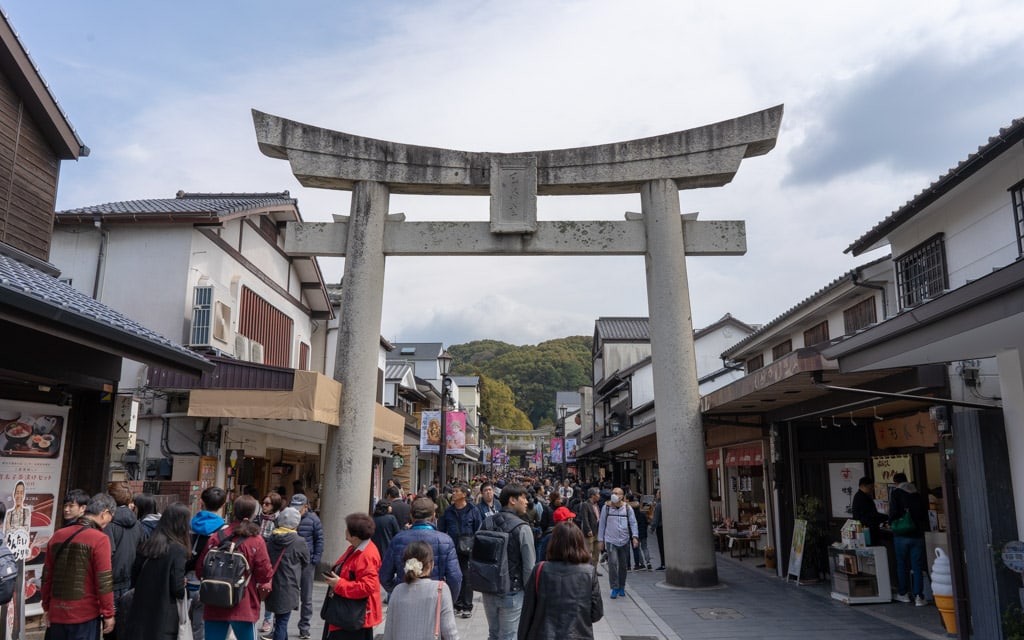
Just outside of the main exit of Dazaifu Station is the entrance to Tenjinsama-dori Street. This street is lined with stores, shops, and restaurants along with large torii gates. Tenjinsama-dori Street leads from the station to the entrance of Dazaifu Tenmangu Shrine, Dazaifu’s most important shrine.
If you only have time to try one food, try the local specialty of Dazaifu, umegae mochi. Umegae mochi, which translates to “plum rice dumpling” was invited in Dazaifu. But, these treats are not plum flavored. Umegae mochi is a sweet dumpling filled with red bean paste and then wrapped in mochi, or rice cake.
Tenjinsama-dori Street is lined with many local shops making and selling umegae mochi. You can peak inside and watch the umegae mochi being prepared in a cast iron mold over a flame. They are truly best hot right off the grill. Crispy on the outside, gooey and sweet on the inside. Shops sell umegae mochi at about 120 yen each.
What not to miss: umegae mochi, local stores
Hours
24 hours
Entrance Fees
Free
How to get to Tenjinsama-dori
Tenjinsama-dori Street begins just outside the main exit of Dazaifu Station.
Dazaifu Tenmangu Shrine

Japan is home to hundreds of Tenmangu shrines. Dazaifu Tenmangu Shrine, along with Kitano Tenmangu Shrine in Kyoto, is one of the most important of these Tenmangu shrines.
Tenmangu shrines are dedicated to the spirit of Sugawara no Michizane (845-903). Michizane was a scholar, poet, and politician during the Heian period (794-1185).
During his childhood, Michizane was a gifted child, composing his own poetry. As a man, Michizane became a politician. He gained influence within the Fujiwara clan dominated imperial court.
His quick rise to power resulted in him being exiled from Kyoto to Dazaifu. Shorlty after his arrival in Dazaifu, Michizane died.
After his death in 903, Japan experience many natural disasters believed caused by the unjust treatment of Michizane. As a result, offerings were made to the spirit of Michizane.
This tradition started the creation of Tenmangu shrines. Dazaifu Tenmangu Shrine is important as it was built on the site of Michizane’s grave.
Today, Michizane has been associated with the Shinto deity of education (Tenjin). Tenmangu shrines are popular among students who visit these shrines to purchase good luck charms and pray in the hope of passing exams.

The entrance into Dazaifu Tenmangu Shrine is located at the end of Tenjinsama-dori, just 300 meters from Dazaifu Station. The shrine is quite large compared to other shrines in Japan. It stretches over 250 meters from end to end. A large torii gate marks the entrance of the shrine grounds.
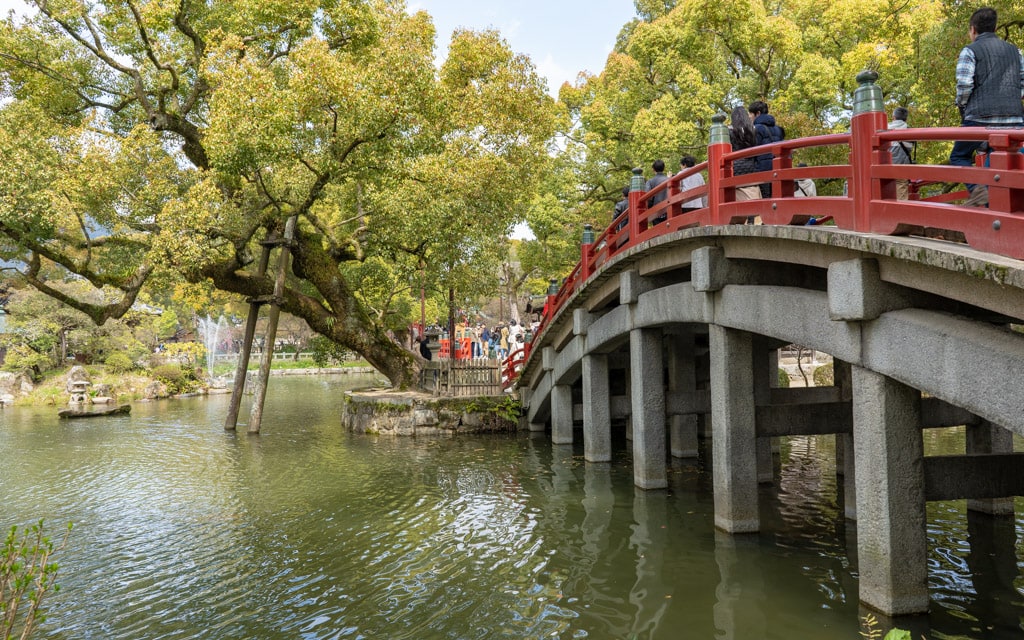
After passing though the gate, visitors encounter Taiko Bridge which crosses Shinji Pond. Taiko Bridge is composed of three sections which symbolize the past, the present, and the future. The pond is shaped in a way to represent the Japanese character for heart. Just off to the right hand side is the Dazaifu Tenmangu Museum. This museum houses and displays important treasures from the shrine.
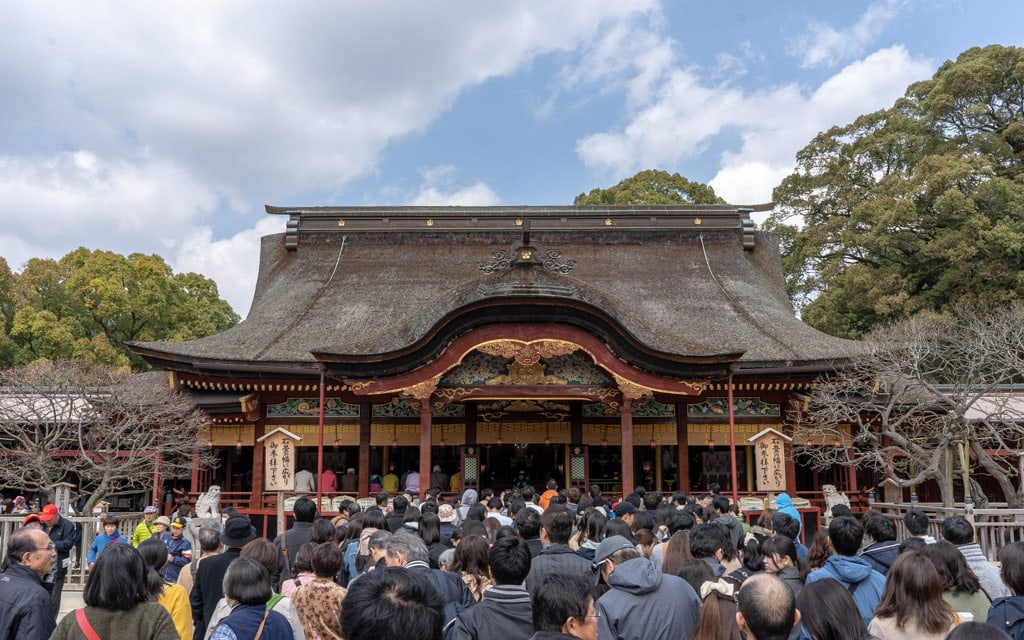
Just past the three bridges is another gate which leads into the courtyard of the shrine. This is where the main hall is located. The main hall, also known as honden in Japanese, dates back to 1591. To the right of the hall is a legendary flying plum tree (tobiume). According to the legend, the tree flew from Kyoto to Dazaifu as Michizane was sent into exile. There are over 5,000 plum trees on the shrine grounds, which Michizane was fond of. Plum trees, which are in bloom during February and March, are a common site at Tenmangu shrines around Japan.
Behind the main hall is a small museum known as Kanko Historical Museum. Inside this museum are small dioramas which teach visitors about the life of Michizane.
What not to miss: flying plum tree, ox statue
Hours
Main Hall
April to May: 6:00AM to 7:00PM
June to August: 6:00AM to 7:30PM
Early to mid September: 6:00AM to 7:00PM
Late September to November: 6:300AM to 7:00PM
December to mid March: 6:30AM to 6:30PM
Late March: 6:00AM to 6:30PM
*Open until 8:30PM on Friday and Saturday
Dazaifu Tenmangu Museum
Tuesday-Sunday: 9:00AM to 4:30PM (last entry at 4:00PM)
Monday: Closed
*If Monday is a national holiday, the museum will be open on that day and closed the following day, Tuesday.
Kanko Historical Museum
Thursday-Monday: 9:00AM to 4:30PM (last entry at 4:00PM)
Tuesday-Wednesday: Closed
Entrance Fees
Main Hall
Free
Dazaifu Tenmangu Museum
400 yen (Dazaifu Tenmangu Museum only)
500 yen (also includes Kanko Historical Museum and Kyushu National Museum)
Kanko Historical Museum
200 yen (Kanko Historical Museum only)
500 yen (also includes Dazaifu Tenmangu Museum and Kyushu National Museum)
How to get to Dazaifu Tenmangu Shrine
From Dazaifu Station, exit and walk 300 meters down Tenjinsama-dori Street to reach the entrance to the shrine.
Komyozenji Temple
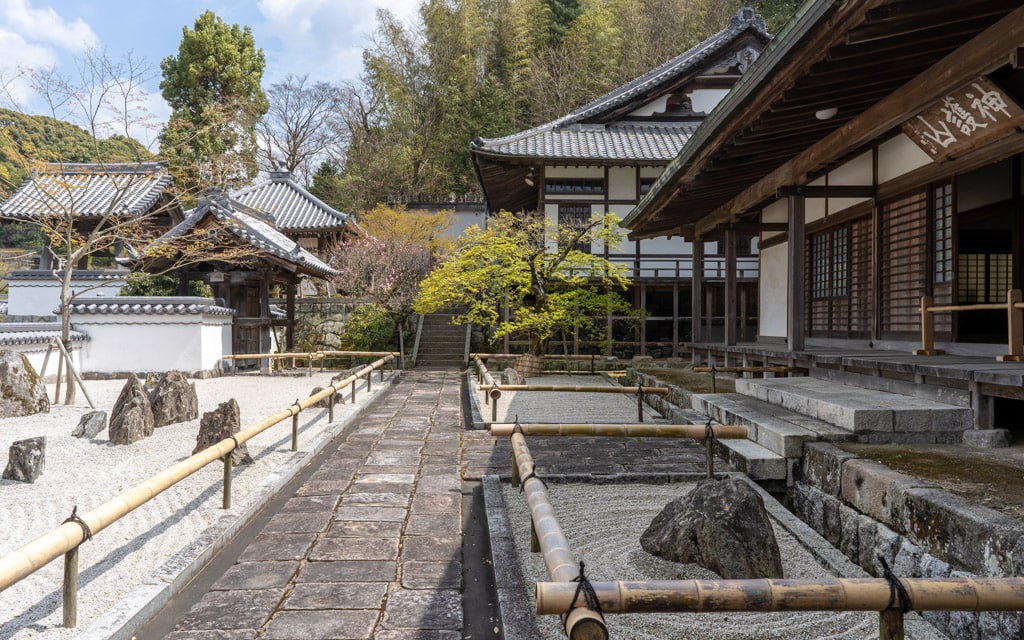
Komyozenji Temple, also known as Kokedera or Moss Temple, is a Zen temple which was built in the 13th century during the Kamakura period (1185–1333).
The main reason for visiting Komyozenji Temple is to view its two Japanese rock gardens. A small garden can be found in front of the temple while a larger one can be found in the rear.
The simple front garden can be entered and viewed for free. This garden features fifteen rocks scattered across raked white pebbles. The rocks are positioned in a way to form the Japanese character for light.
To enter the temple and view the rear garden, an entrance fee of 200 yen must be paid. Unfortunately, photographs are not allowed inside Komyozenji Temple including the rear garden.
The rear garden, which was built in 1957, can be viewed from the main temple building. Just as with the front garden, the rear garden incorporates rocks placed in specific locations around the garden. Large patches of green moss can be found stretched across the garden like islands in a sea of raked white pebbles.
The temple is a popular spot for falls colors when the maple trees planted in the garden begin to change colors around the middle of November.
What not to miss: rear garden, front garden
Hours
Open daily from 8:00 AM to 5:00 PM
Entrance Fees
200 yen
How to get to Komyozenji Temple
From Dazaifu Station, exit and walk 300 meters down Tenjinsama-dori Street. When you reach the torii gate at the entrance of Dazaifu Tenmangu Shrine, turn right. Continue for 120 meters to reach the temple.
Kyushu National Museum

Kyushu National Museum, which is housed in a futuristic looking blue building, is the fourth national museum to open in Japan. The other three museums, which were built in the 1800s, are located in Tokyo, Kyoto, and Nara. All four of these museums are part of the National Institutes for Cultural Heritage (NICH). Since opening on October 16, 2005, the museum has welcomed more than 15 million visitors.
Entrance into the first floor hall is free for all visitors. When you walk in, look up to see the highlight of this spacious hall, the ceiling made of Kyushu cedar. Also free to enter on the same floor is an interactive exhibition gallery known as Ajippa. This hands-on exhibit features costumes, musical instruments, and games. A cafe, restaurant, and museum shop can also be found on the first floor.
Special exhibitions can be found on the third floor. These exhibitions, which change every few months, feature artifacts from not only Japan but overseas.
The main exhibition, known as the Cultural Exchange Exhibition, can be found on the fourth floor. This exhibit explores Japanese history from the Prehistoric Era to the Edo period along with Japan’s cultural exchange with Asia and Europe.
What not to miss: entrance hall, main exhibit on fourth floor, special exhibitions
Hours
Sunday-Thursday: 9:30AM to 5:00PM
Friday-Saturday: 9:30AM to 8:00PM
Monday: Closed*
*If a holiday falls on Monday, the museum will be open that day and closed on the following day, Tuesday.
Entrance Fees
Adult (under 70): 430 yen
College Students: 130 yen
Childen (under 18) and Seniors (over 70): Free
Additional cost for special exhibitions.
From Dazaifu Station
The museum is located about one kilometer east of the station.
Kamado Shrine

Kamado Shrine (Kamado-jinja) is a Shinto shrine located at the base of Mount Hōman in a quieter part of Dazaifu. This shrine is located off the beaten path. You won’t find many tourists here.

The main hall (haiden), which dates back to 1927, is located at the base of the mountain. Another smaller hall is located at the summit of Mount Hōman.
Since ancient times, Mount Hōman has been regarded as a sacred spot. The mountain, along with the shrine, have been designated a National historic site.
Kamado Shrine is believed to have been founded by Emperor Tenji in 673 when he built a castle in the area. The shrine is dedicated to Emperor Ōjin, his mother Empress Jinugu, and Tamayori-hime who is a mythical Japanese goddess known as the deity of love and matchmaking. The shrine is a popular spot for those looking for love. Many write down wishes for everlasting love on small wooden plaques known as ema.
In the spring, the shrine is a popular spot for cherry blossom viewing. In the fall, the temple grounds are beautiful as many ginko trees begin to change colors into vibrant shades of red, orange, and yellow.
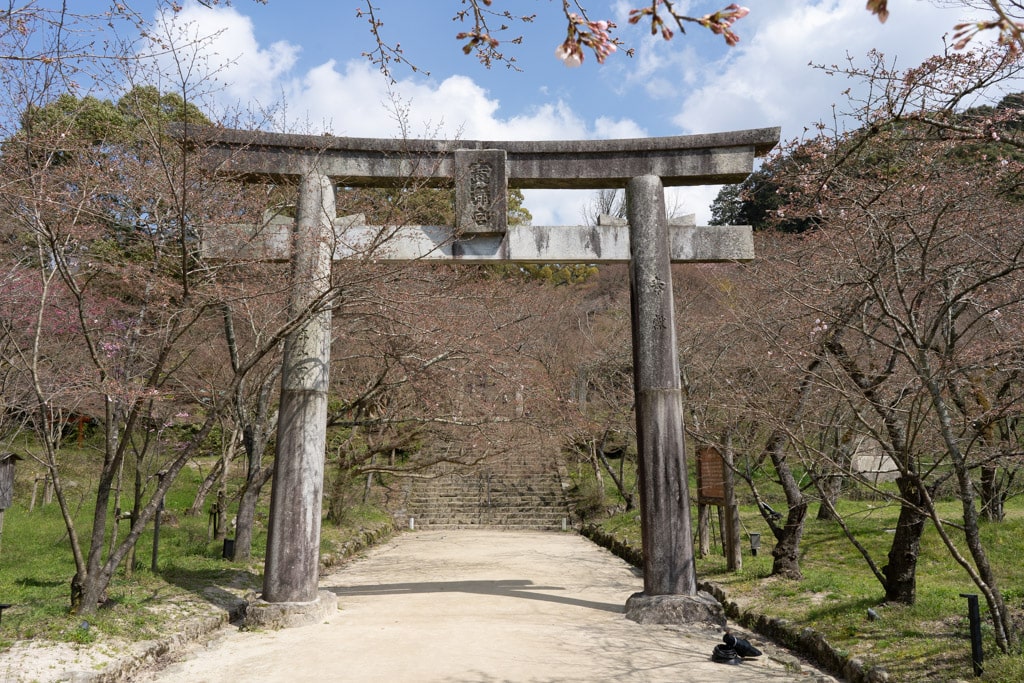
Hours
24 hours
Entrance Fees
Free
How to get to Kamado Shrine
From outside Dazaifu Station, take a local bus to Uchiyama Bus Stop.
Kanzeonji Temple

Kanzeonji Temple is a Buddhist temple of the Tendai sect. During the Nara period (710-794) and the Heian period (794-1185), Dazaifu was the political center of Kyushu. Kanzeonji was its most important temple.
Construction on the temple was completed in 746. The temple was built by Emperor Tenji in honor of his late mother, Empress Saimei would died in 661. When completed, the temple featured two large gates, a pagoda to the east, a golden hall, and a lecture hall.
Over the years, as Dazaifu lost its political power, the temple fell into despair. Many of the temple buildings, including the pagoda and some of the gates, were lost due to natural disasters, fires, and wars. The main hall and lecture hall as seen today were rebuilt in the 17th century during the Genroku era (1688-1703).
The bell hanging in the tower dates back to the 7th century. This bell, which was built during the Nara period (710-794), is one of the oldest surviving bells in Japan. It has been designated a National Treasure
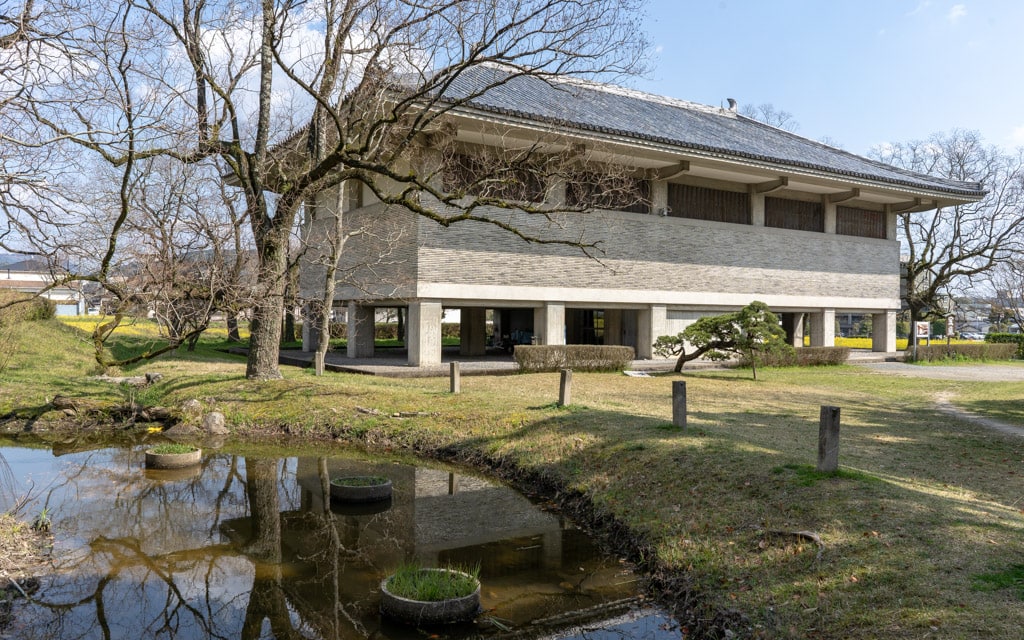
On the eastern side of the temple grounds is the treasure hall. This 1950s building houses many Important Cultural Properties from the Nara period, Heian period, and Kamakura period including large wooden Buddhist statues. These statues were previously housed inside the halls of the temple.
What not to miss: 7th century bell, treasure hall
Hours
Temple Grounds
24 hours
Treasure Hall
Open daily from 9:00AM to 5:00PM (last entry at 4:30PM)
Entrance Fees
Temple Grounds
Free
Treasure Hall
500 yen
How to get to Kanzeonji Temple
From outside Dazaifu Station, take a local bus to Dazaifu Shiyakusho-mae (City Hall) Bus Stop. The entrance to the temple is located 200 meters west of the bus stop on the opposite side of the road.
Kaidanin Hall (Buddhist Ordination Hall)

Located just steps to the west from Kanzeonji Temple is Kaidanin Hall, also known as the Buddhist Ordination Hall. This Rinzai-sect temple hall was once part of Kanzeonji Temple but was later separated.
Kaidanin Hall was originally constructed in 761 during the Nara period (710-794). The hall was founded by a Chinese monk known as Jianzhen (688-763). In Japan, he is known as Ganjin. Ganjin was invited by the emperor of Japan to help spread Buddhism across Japan by teaching and training monks. After his invitation, it took Ganjin six tries over the years to reach Japan from China, thanks in part to bad weather and government intervention. By the time he made it to Japan, he lost his eyesight due to an infection.
Along with Kaidanin Hall, Ganjin founded Toshodaiji Temple in Nara. When built, Kaidanin Hall served as one of three halls in Japan where Buddhist monks could be officially ordained. The other halls were located at Todaiji Temple in Nara and the former Yakushiji Temple in Tochigi.

Kaidanin, as seen today, dates back to the 17th century during the Edo period (1603-1868). This includes the main hall, a bell tower, and a small gate. Inside the main hall is a Vairocana Buddha from the Heian period. The seated Buddha is made of lacquer and coated with gold leaf. To the side are two Bodhisattva.


What not to miss: the main hall
Hours
24 hours
Entrance Fees
Free
How to get to Kaidanin Hall
From outside Dazaifu Station, take a local bus to Dazaifu Shiyakusho-mae (City Hall) Bus Stop. The entrance to the temple is located 270 meters west of the bus stop on the opposite side of the road.
Government Office Ruins

During the Nara period (710-794) and the Heian period (794-1185), Dazaifu was the political center of the island of Kyushu. At the center of politics in Dazaifu was the Government Office.
The government office was composed of administrative buildings, offices, and guest houses used to greet foreign dignitaries. Many of these buildings, which were arranged in a symmetrical grid, were built in the Chodo-in style, similar to Heijō Palace in Nara.
Over the centuries, Dazaifu lost its political influence. The government buildings fell into ruins and were eventually destroyed, leaving only the foundations of buildings that stood for over a thousand years.
Today, the Government Office Ruins is a public park. During the day you will see people having picnics, walking dogs, children running around, and people flying kites.

In the southeast corner of the park is the Dazaifu Exhibition Hall. Inside the hall are archaeological displays and artifacts discovered over the years. You will also find information about the history of the government office.
What not to miss: Dazaifu Exhibition Hall
Hours
Government Office Ruins
24 hours
Dazaifu Exhibition Hall
9:00AM to 4:30PM
Entrance Fees
Government Office Ruins
Free
Dazaifu Exhibition Hall
Free
How to get to Government Office Ruins
From outside Dazaifu Station, take a local bus to Dazaifu Seichoato Bus Stop. The ruins are located 130 meters west of the bus stop on the opposite side of the road.
Last Updated on April 16, 2024
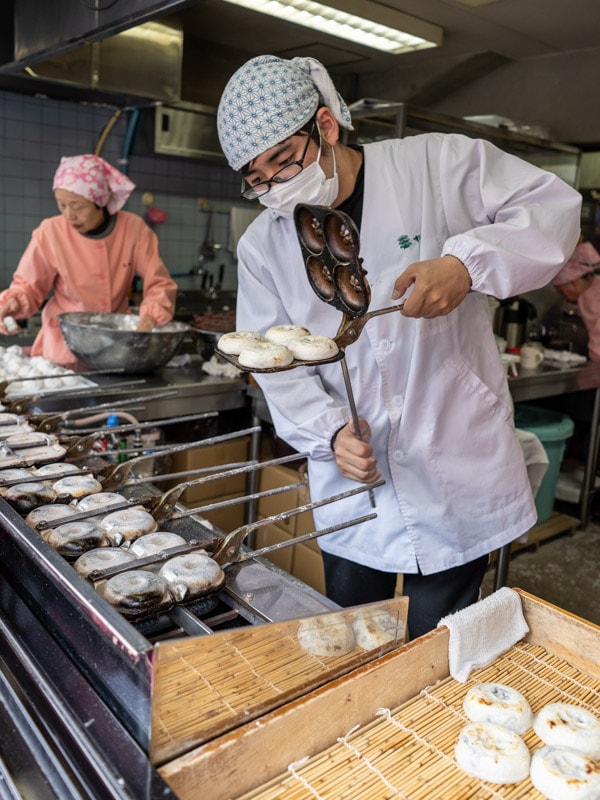

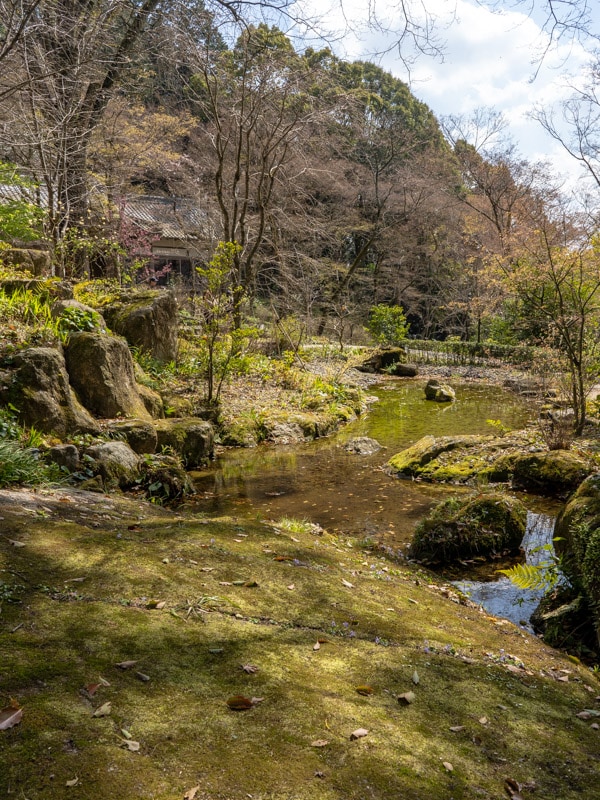
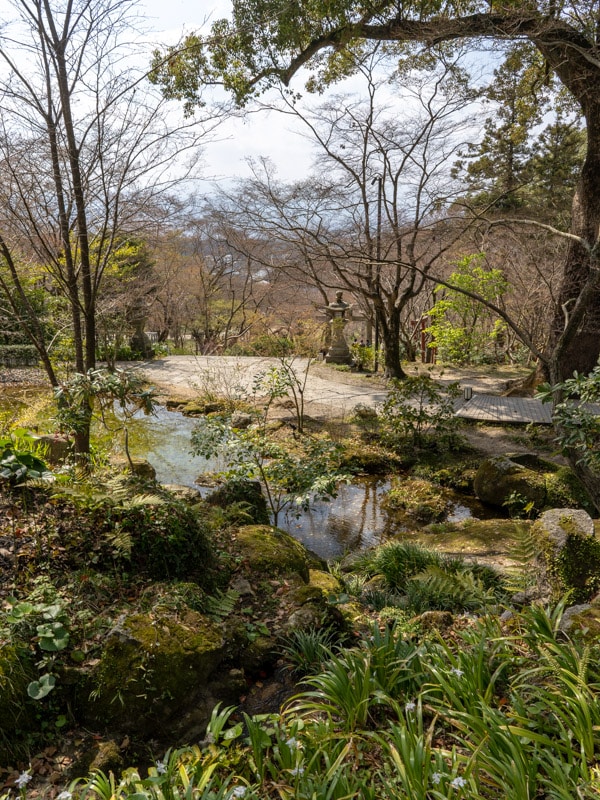
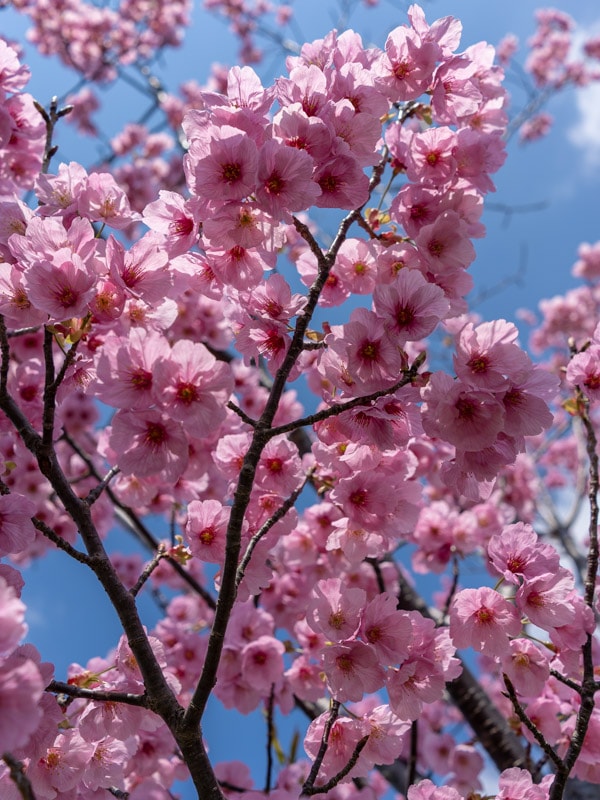

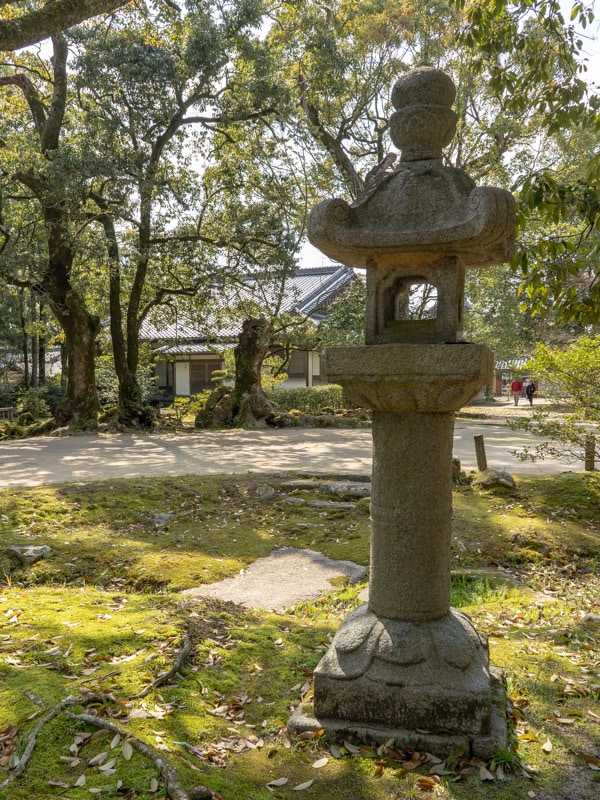
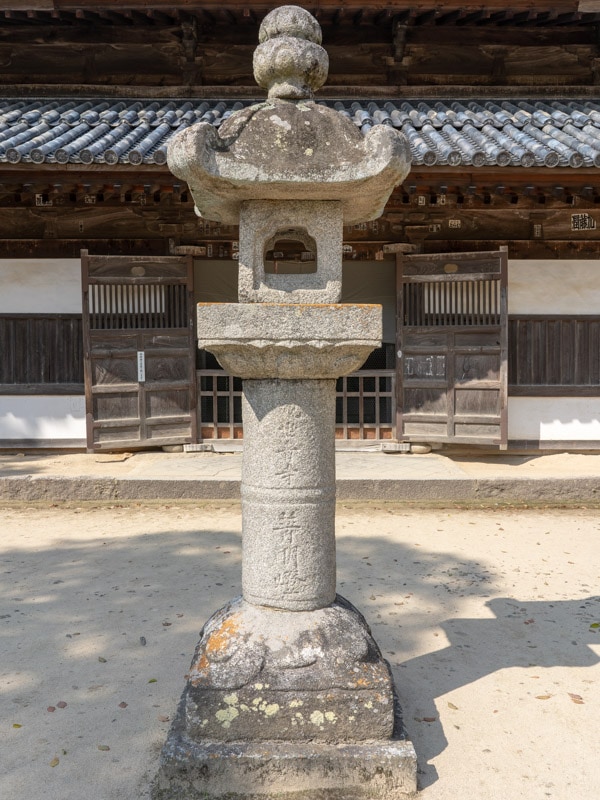

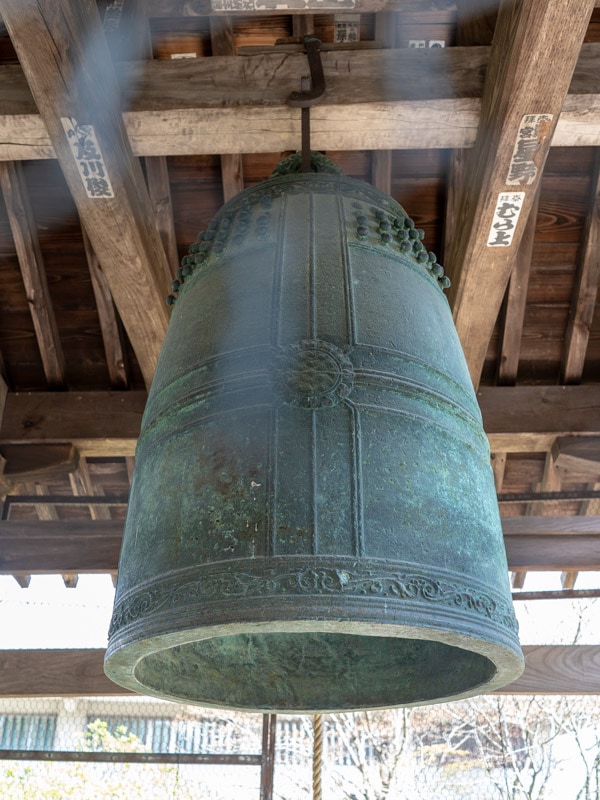



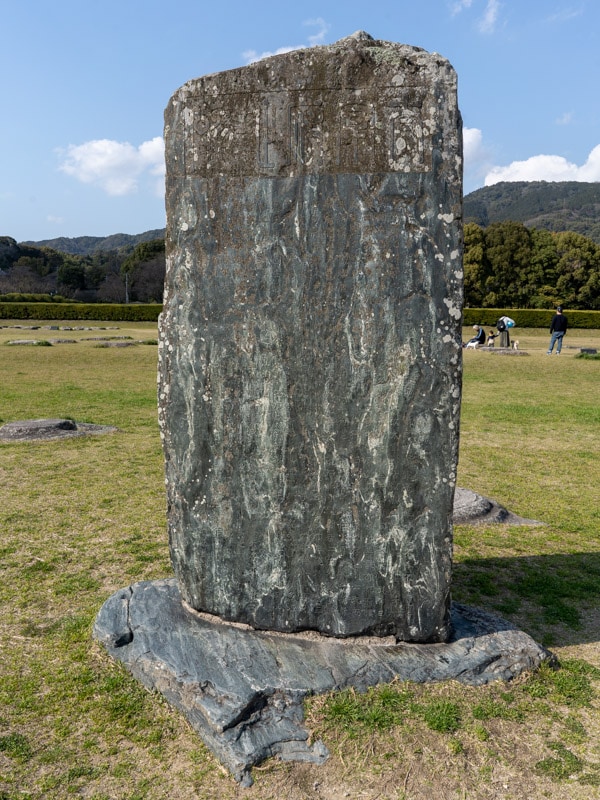
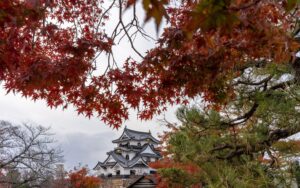
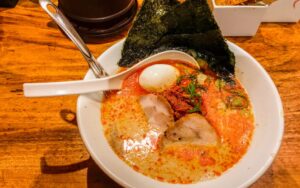


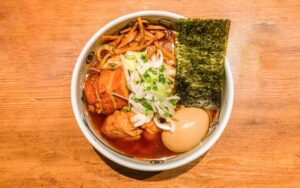



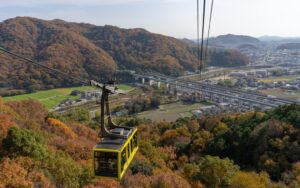

Thank you for your very detailed guide! It’s super helpful! I’m going there this fall. 🙂
Thank you for the info. It so useful for me to plan my coming itineraries
KK,
Enjoy your trip to Dazaifu.
Thanks for the very detailed info about Dazaifu. Based on this, I find Dazaifu quite an interesting place to visit and decided to include it in my itinerary. 🙂
Flor D,
Enjoy your trip to Dazaifu!
Thank you for this incredibly detailed and helpful report. I look forward to visiting all the places mentioned next November.
I already booked an over-night stay in Fukuoka because I wanted to see the reclining Buddha at the Nanzoin Temple but I see now that I need to book a second night to take in all that you have so kindly told us about!